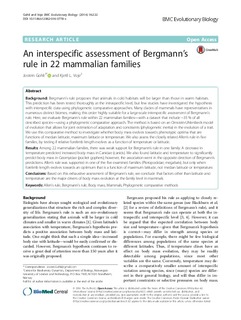| dc.contributor.author | Gohli, Jostein | |
| dc.contributor.author | Voje, Kjetil L. | |
| dc.date.accessioned | 2016-10-31T19:15:54Z | |
| dc.date.accessioned | 2016-11-02T12:07:43Z | |
| dc.date.available | 2016-10-31T19:15:54Z | |
| dc.date.available | 2016-11-02T12:07:43Z | |
| dc.date.issued | 2016 | |
| dc.identifier.citation | BMC Evolutionary Biology 2016, 16(222) | nb_NO |
| dc.identifier.issn | 1471-2148 | |
| dc.identifier.uri | http://hdl.handle.net/11250/2418907 | |
| dc.description.abstract | Background:
Bergmann’s rule proposes that animals in cold habitats will be larger than those in warm habitats. This prediction has been tested thoroughly at the intraspecific level, but few studies have investigated the hypothesis with interspecific data using phylogenetic comparative approaches. Many clades of mammals have representatives in numerous distinct biomes, making this order highly suitable for a large-scale interspecific assessment of Bergmann’s rule. Here, we evaluate Bergmann’s rule within 22 mammalian families—with a dataset that include ~35 % of all described species—using a phylogenetic comparative approach. The method is based on an Ornstein-Uhlenbeck model of evolution that allows for joint estimation of adaptation and constraints (phylogenetic inertia) in the evolution of a trait. We use this comparative method to investigate whether body mass evolves towards phenotypic optima that are functions of median latitude, maximum latitude or temperature. We also assess the closely related Allen’s rule in five families, by testing if relative forelimb length evolves as a function of temperature or latitude.
Results:
Among 22 mammalian families, there was weak support for Bergmann’s rule in one family: A decrease in temperature predicted increased body mass in Canidae (canids). We also found latitude and temperature to significantly predict body mass in Geomyidae (pocket gophers); however, the association went in the opposite direction of Bergmann’s predictions. Allen’s rule was supported in one of the five examined families (Pteropodidae; megabats), but only when forelimb length evolves towards an optimum that is a function of maximum latitude, not median latitude or temperature.
Conclusions:
Based on this exhaustive assessment of Bergmann’s rule, we conclude that factors other than latitude and temperature are the major drivers of body mass evolution at the family level in mammals. | nb_NO |
| dc.language.iso | eng | nb_NO |
| dc.publisher | BioMed Central | nb_NO |
| dc.relation.uri | http://bmcevolbiol.biomedcentral.com/articles/10.1186/s12862-016-0778-x | |
| dc.rights | Navngivelse 3.0 Norge | * |
| dc.rights | Navngivelse 3.0 Norge | * |
| dc.rights | Navngivelse 3.0 Norge | * |
| dc.rights.uri | http://creativecommons.org/licenses/by/3.0/no/ | * |
| dc.rights.uri | http://creativecommons.org/licenses/by/3.0/no/ | * |
| dc.rights.uri | http://creativecommons.org/licenses/by/3.0/no/ | * |
| dc.title | An interspecific assessment of Bergmann’s rule in 22 mammalian families | nb_NO |
| dc.type | Journal article | nb_NO |
| dc.type | Peer reviewed | nb_NO |
| dc.date.updated | 2016-10-31T19:15:54Z | |
| dc.source.volume | 16 | nb_NO |
| dc.source.journal | BMC Evolutionary Biology | nb_NO |
| dc.source.issue | 222 | nb_NO |
| dc.identifier.doi | 10.1186/s12862-016-0778-x | |
| dc.identifier.cristin | 1393462 | |
| dc.description.localcode | © The Author(s). 2016. This article is distributed under the terms of the Creative Commons Attribution 4.0 International License (http://creativecommons.org/licenses/by/4.0/), which permits unrestricted use, distribution, and reproduction in any medium, provided you give appropriate credit to the original author(s) and the source, provide a link to the Creative Commons license, and indicate if changes were made. The Creative Commons Public Domain Dedication waiver (http://creativecommons.org/publicdomain/zero/1.0/) applies to the data made available in this article, unless otherwise stated. | nb_NO |

